Evaluation of Chitosan Derivative Microparticles Encapsulating Superparamagnetic Iron Oxide and Doxorubicin as a pH-Sensitive Delivery Carrier in Hepatic Carcinoma Treatment: An in vitro Comparison Study
- PMID: 30298001
- PMCID: PMC6160595
- DOI: 10.3389/fphar.2018.01025
Evaluation of Chitosan Derivative Microparticles Encapsulating Superparamagnetic Iron Oxide and Doxorubicin as a pH-Sensitive Delivery Carrier in Hepatic Carcinoma Treatment: An in vitro Comparison Study
Abstract
We developed a novel, pH-sensitive drug delivery microparticle based on N-palmitoyl chitosan (NPCS) to transport the superparamagnetic iron oxide (SPIO) and anticancer drug doxorubicin (DOX). The characteristics of NPCS were characterized through nuclear magnetic resonance. Our results based on testing of volume swelling in multiple pH aqueous solutions revealed that the modified chitosan had a pH-sensitive property. The morphology and size of the DOX-SPIO/NPCS microparticles were investigated using transmission electron microscopy and scanning electron microscopy. The statistical result of microparticles had diameter of 185 ± 87 nm. Surface chemical moieties of DOX-SPIO/NPCS microparticles were confirmed using attenuated total reflection Fourier transform infrared spectroscopy and indicated the existence of mostly hydrophilic groups such as -OH, -C=O, and -C-O-C-. Transmission electron microscopy revealed the dark contrast of SPIO dots encapsulated in the NPCS matrix. Nuclear magnetic resonance T2-weighted magnetic resonance imaging confirmed that the produced DOX-SPIO/NPCS microparticles still exhibited T2 relaxation durations as short as 37.68 ± 8.69 ms (under administration of 2.5 μg/mL), which is comparable to the clinically required dosage. In the drug release profile, the DOX-SPIO/NPCS drug delivery microparticle was accelerated in an acidic environment (pH 6.5) compared with that in a basic environment. Microparticles in a cytotoxicity assay (3-[4,5-dimethylthiazol-2-yl]-2,5-diphenyltetrazolium bromide assay) revealed that DOX-SPIO/NPCS microparticles had better antitumor ability than did free-form of DOX. Additionally, microparticles loaded with 0.5-5 μg/mL DOX in an acidic environment (pH 6.5) demonstrated higher efficacy against Hep G2 cell growth, possibly because of the swelling effect of NPCS, resulting in volume expansion and easy drug release. Accordingly, these large DOX-SPIO/NPCS microparticles showed potential for application as a pH-sensitive drug delivery system and as chemoembolization particles for hepatic carcinoma therapy.
Keywords: doxorubicin; electrospray; microparticle; nanotechnology; superparamagnetic iron oxide.
Figures
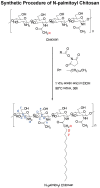

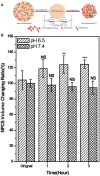
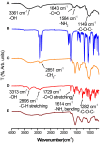
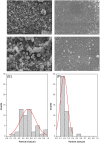

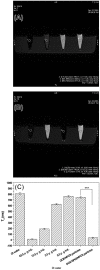

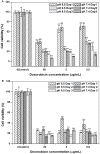
Similar articles
-
Development and application of micro-polysaccharide drug carriers incorporating doxorubicin and superparamagnetic iron oxide for bimodality treatment of hepatocellular carcinoma.Colloids Surf B Biointerfaces. 2017 Mar 1;151:304-313. doi: 10.1016/j.colsurfb.2016.12.036. Epub 2016 Dec 23. Colloids Surf B Biointerfaces. 2017. PMID: 28040662
-
Hollow superparamagnetic iron oxide nanoshells as a hydrophobic anticancer drug carrier: intracelluar pH-dependent drug release and enhanced cytotoxicity.Nanoscale. 2012 Sep 21;4(18):5744-54. doi: 10.1039/c2nr30960b. Epub 2012 Aug 16. Nanoscale. 2012. PMID: 22895638
-
Multifunctional pH-sensitive superparamagnetic iron-oxide nanocomposites for targeted drug delivery and MR imaging.J Control Release. 2013 Aug 10;169(3):228-38. doi: 10.1016/j.jconrel.2013.02.015. Epub 2013 Feb 26. J Control Release. 2013. PMID: 23485450
-
Doxorubicin-loaded poly(ethylene oxide)-trimellitic anhydride chloride-folate superparamagnetic iron oxide nanoparticles.2010 Jul 16 [updated 2010 Sep 23]. In: Molecular Imaging and Contrast Agent Database (MICAD) [Internet]. Bethesda (MD): National Center for Biotechnology Information (US); 2004–2013. 2010 Jul 16 [updated 2010 Sep 23]. In: Molecular Imaging and Contrast Agent Database (MICAD) [Internet]. Bethesda (MD): National Center for Biotechnology Information (US); 2004–2013. PMID: 20945566 Free Books & Documents. Review.
-
Effects and interactions of metal oxides in microparticle-enhanced cultivation of filamentous microorganisms.Eng Life Sci. 2021 Dec 2;22(12):725-743. doi: 10.1002/elsc.202100075. eCollection 2022 Dec. Eng Life Sci. 2021. PMID: 36514528 Free PMC article. Review.
Cited by
-
Effects of Chitosan Oligosaccharides on Human Blood Components.Front Pharmacol. 2018 Dec 3;9:1412. doi: 10.3389/fphar.2018.01412. eCollection 2018. Front Pharmacol. 2018. PMID: 30559672 Free PMC article.
-
Progress in the Development of Chitosan-Based Biomaterials for Tissue Engineering and Regenerative Medicine.Biomolecules. 2019 Sep 10;9(9):470. doi: 10.3390/biom9090470. Biomolecules. 2019. PMID: 31509976 Free PMC article. Review.
-
CD133 Targeted PVP/PMMA Microparticle Incorporating Levamisole for the Treatment of Ovarian Cancer.Polymers (Basel). 2020 Feb 20;12(2):479. doi: 10.3390/polym12020479. Polymers (Basel). 2020. PMID: 32093199 Free PMC article.
-
Research progress in the application of in situ hydrogel system in tumor treatment.Drug Deliv. 2020 Dec;27(1):460-468. doi: 10.1080/10717544.2020.1739171. Drug Deliv. 2020. PMID: 32166987 Free PMC article. Review.
-
Smart nanoparticles and microbeads for interventional embolization therapy of liver cancer: state of the art.J Nanobiotechnology. 2023 Feb 6;21(1):42. doi: 10.1186/s12951-023-01804-7. J Nanobiotechnology. 2023. PMID: 36747202 Free PMC article. Review.
References
-
- Bai M. Y., Liu S. Z. (2014). A simple and general method for preparing antibody-PEG-PLGA sub-micron particles using electrospray technique: an in vitro study of targeted delivery of cisplatin to ovarian cancer cells. Colloids Surf. B Biointerf. 117, 346–353. 10.1016/j.colsurfb.2014.02.051 - DOI - PubMed
-
- Bai M. Y., Yang H. C. (2013). Fabrication of novel niclosamide-suspension using an electrospray system to improve its therapeutic effects in ovarian cancer cells in vitro. Colloids Surf. A Physicochem. Eng. Aspects 419, 248–256. 10.1016/j.colsurfa.2012.11.076 - DOI
-
- Balan V., Dodi G., Tudorachi N., Ponta O., Simon V., Butnaru M., et al. (2015). Doxorubicin-loaded magnetic nanocapsules based on N-palmitoyl chitosan and magnetite: synthesis and characterization. Chem. Eng. J. 279, 188–197. 10.1016/j.cej.2015.04.152 - DOI
-
- Bruix J., Llovet J. M., Castells A., Montañá X., Brú C., Ayuso M. D. C., et al. . (1998). Transarterial embolization versus symptomatic treatment in patients with advanced hepatocellular carcinoma: results of a randomized, controlled trial in a single institution. Hepatology 27, 1578–1583. 10.1002/hep.510270617 - DOI - PubMed
LinkOut - more resources
Full Text Sources

